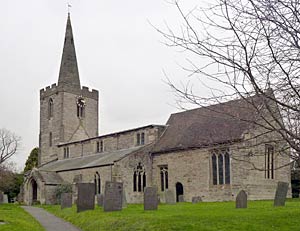< Previous | Contents | Next >
Seventeen Silver Inkstands

Holy Trinity church, Wysall in 2014.
© Copyright Alan Murray-Rustand licensed for reuse under this Creative Commons Licence.
WYSALL. Time brings little change to this quiet village on the edge of the Wolds. At one end of a short road shaded by stately trees is a beautiful church with something of perhaps a thousand years ago; at the other end is an inn with a pump trough said to have been hollowed out of the top of a Norman pillar. Below the village a brook flows from the heart of the Wolds, on its way to the Soar.
Wise restoration has left the church with all the dignity of lovely old age. We read its oldest story in the north wall of the nave—in rubble walling which may be Saxon, in a Norman doorway, and in a charming little Norman window.
The lovely font with a round bowl on five shafts saw the dawn of the 13th century, and from its close comes most of the tower, with an earlier arch resting on foliage corbels, and a 15th century window; its small spire is 600 years old. The belfry is reached by a wonderful old ladder with a handrail and candle spike. The nave arcade, and the aisle with a fine east window, are 14th century. From the end of the 14th comes the chancel, and the clerestory is 100 years younger.
The 15th century screen (with gates and a massive middle rail) has small holes in two panels which were used as peepholes to the altar. The oak pulpit of about 1400, perhaps the oldest in the county, has come into its own again after having been displaced by one of stone. Three sturdy oak benches are over 400 years old; there is an old chest, and two old miserere seats are carved with quaint faces. Very impressive is the old timbering of the chancel roof.
The dainty brass candelabra in the chancel was given "for the use of Psalm singers of Wysall church in 1773." A painted wood panel is a memorial to George Widmerpole of 1689, and on an alabaster tomb lie the splendid figures of Hugh Armstrong and his wife Mary Sacheverell, both wearing ruffs. The knight is in armour with a double chain round his neck, a book in his hand, his feet on a lion, and a pair of gauntlets at his side. His lady's Elizabethan dress is held by a long chain, her arms are gone, and a tiny dog is at her feet. Round the tomb are their seven children.
Proud he would be, this knight in his armour, if he could know that from his old village 17 men went out to the war and came home again; it is one of three Thankful Villages in the county. Wysall has no Roll of Honour, but every man was presented with a silver inkstand on which was engraved his name and the words, "With gratitude from Wysall for answering Duty's call in the Great War."
